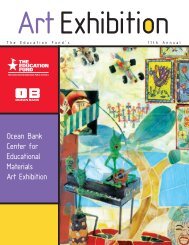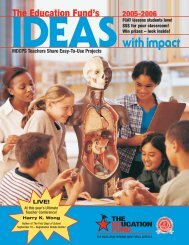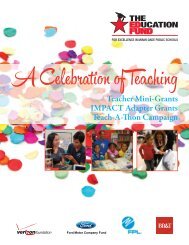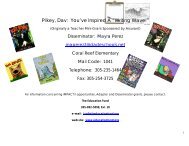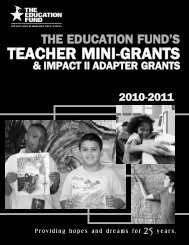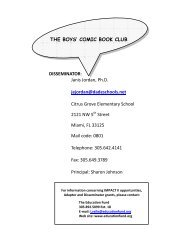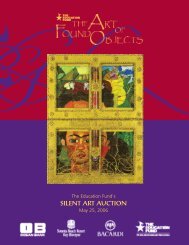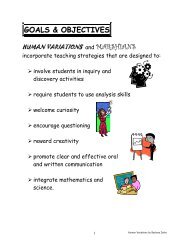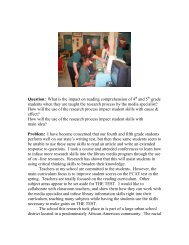Found Figurative Language by Terri Sabbag - The Education Fund
Found Figurative Language by Terri Sabbag - The Education Fund
Found Figurative Language by Terri Sabbag - The Education Fund
You also want an ePaper? Increase the reach of your titles
YUMPU automatically turns print PDFs into web optimized ePapers that Google loves.
What is being compared? Students may say that clouds and cotton balls are<br />
being compared. I require more precise details than that. What aspects of the<br />
clouds are being compared? <strong>The</strong>ir shape, color, texture?<br />
6. Have students form their small groups from the previous lesson to use the<br />
“pencil” personifications that they created.. Students are to discuss other things<br />
they can use to compare the way the pencil feels, sounds, looks, etc. during the<br />
timed multiplication test.<br />
7. Encourage students to associate body parts with the pencil as they create<br />
similes. (For example: <strong>The</strong> pencil point was a sharp as a pin, ready to conquer<br />
the math test.)<br />
Evaluation: Check students’ similes; star any sentences that are especially creative to<br />
be shared the next day with the whole group.<br />
Home Learning:<br />
1. Students will choose a weather phenomenon and create 2 similes comparing its<br />
appearance, force, effects, etc.<br />
2. Instruct students to search for similes in their independent reading. <strong>The</strong>y should<br />
mark the page with a Post-it note, without interrupting the flow of their reading.<br />
<strong>The</strong>y can later go back and write the simile sentence on the Post-it note and<br />
leave it on the page where it was found. <strong>The</strong>y should be prepared to share<br />
examples with the class.<br />
Adapt Simile Lesson Plan to Teach Metaphors:<br />
Activity:<br />
1. Explain that metaphors are similar to similes because they compare two things.<br />
However, metaphors are more potent than similes because they state that one<br />
thing ‘is’ another thing; like and as are not used in the comparison.<br />
2. Provide examples of metaphors (e.g., grass is nature’s blanket) and discuss the<br />
things being compared. Metaphors are not as easy to identify as similes. It is<br />
helpful to identify the aspect that is being compared. (e.g., size, shape, feeling,<br />
sound, etc.)<br />
3. Using the similes created in the previous pencil lesson, work with the students to<br />
adapt the similes <strong>by</strong> taking out the ‘like’ or ‘as’ to create metaphors. (e.g., <strong>The</strong><br />
pinpoint pencil tip stood at attention, ready to conquer the math test.)<br />
Page 7 of 18



